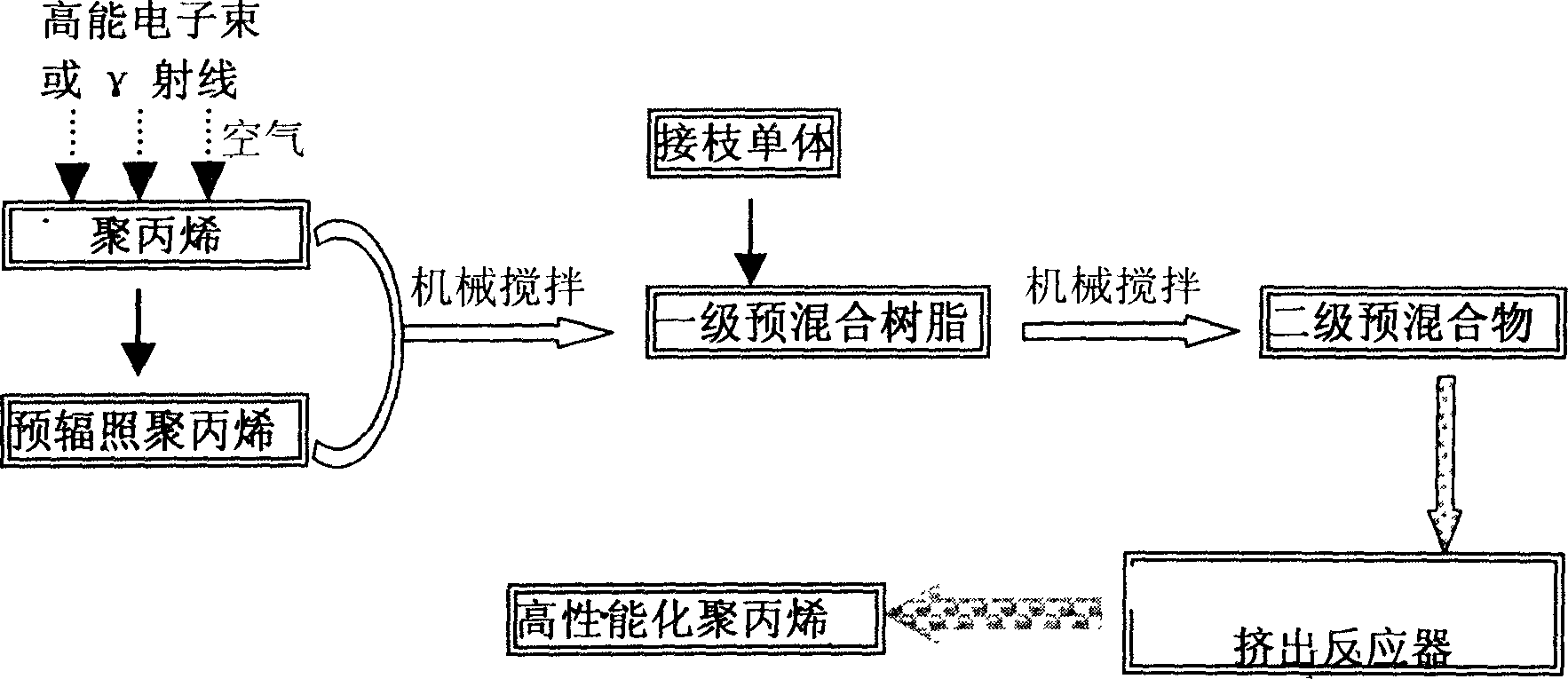Process for preparing functional poly propylene material
A polypropylene material and a functionalized technology, which is applied in the field of preparation of functionalized polypropylene materials, can solve the problems of deep product and decreased mechanical properties, and achieve the effects of alleviating degradation reaction, reducing production cost and reducing irradiation treatment cost.
- Summary
- Abstract
- Description
- Claims
- Application Information
AI Technical Summary
Problems solved by technology
Method used
Image
Examples
Embodiment 1
[0038] The raw materials are copolymerized polypropylene and pre-irradiated copolymerized polypropylene. The polar unsaturated monomer is acrylic acid. The melt flow rate of the copolymerized polypropylene is 3.3g / 10min. It is isotactic polypropylene and the form is powder. Acrylic acid is a commercial Analytical reagents sold.
[0039] The pre-irradiation treatment of polypropylene is to spread the copolymerized polypropylene powder uniformly in an open container, and then transport it through the radiation area by an automatic conveyor. Under air conditions, it is pre-irradiated with an electron beam. The irradiation dose is 4kGy. Illumination dose rate 10 5 kGy / h, the irradiation time is 0.1s, and the melt flow rate of polypropylene after irradiation is 43.3g / 10min.
[0040] Mechanically mix 5 parts (mass) of the above-mentioned pre-irradiated polypropylene and 95 parts (mass) of unirradiated polypropylene to obtain a first-level pre-mixed resin; then add 0.8% acrylic acid base...
Embodiment 2
[0047] The raw materials are the same as in Example 1, the mass ratio of non-irradiated polypropylene and pre-irradiated polypropylene is changed to 90:10, the amount of polar unsaturated monomer acrylic acid is 0.8%, and the remaining steps are the same as in Example 1.
[0048] The grafting rate of the obtained product is 0.17%, and its melt flow rate is 4.3g / 10min, which is slightly larger than the value of the raw material polypropylene, indicating that there is a partial degradation reaction during the grafting process, and a small amount of low molecular weight products are produced. It is basically the same as the raw material polypropylene. Other physical and mechanical performance test results are shown in Table 1.
Embodiment 3
[0053] The raw materials are the same as in Example 1. The amount of pre-irradiated polypropylene is increased so that the mass ratio of polypropylene to unirradiated polypropylene is 15:85, and the amount of the polar unsaturated monomer acrylic acid is 0.8%. The remaining steps are the same as in Example 1. the same.
[0054] The grafting rate of the obtained product is 0.27%, the melt flow rate is 3.9g / 10min, and the tensile properties and impact strength are lower than that of the raw material. This is because the increase in the amount of pre-irradiated polypropylene produces more degradation , Resulting in a decrease in mechanical properties, which proves that the amount of pre-irradiated polypropylene used as an "initiator" can be easily adjusted to achieve the purpose of controlling the degree of degradation of the product. Other physical and mechanical performance test results are shown in Table 1.
PUM
| Property | Measurement | Unit |
|---|---|---|
| The melt flow rate | aaaaa | aaaaa |
| The melt flow rate | aaaaa | aaaaa |
| The melt flow rate | aaaaa | aaaaa |
Abstract
Description
Claims
Application Information
 Login to View More
Login to View More - R&D Engineer
- R&D Manager
- IP Professional
- Industry Leading Data Capabilities
- Powerful AI technology
- Patent DNA Extraction
Browse by: Latest US Patents, China's latest patents, Technical Efficacy Thesaurus, Application Domain, Technology Topic, Popular Technical Reports.
© 2024 PatSnap. All rights reserved.Legal|Privacy policy|Modern Slavery Act Transparency Statement|Sitemap|About US| Contact US: help@patsnap.com










